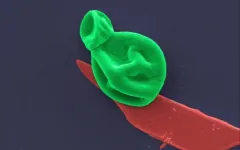(Press-News.org) Researchers have developed a new superbug-destroying coating that could be used on wound dressings and implants to prevent and treat potentially deadly bacterial and fungal infections.
The material is one of the thinnest antimicrobial coatings developed to date and is effective against a broad range of drug-resistant bacteria and fungal cells, while leaving human cells unharmed.
Antibiotic resistance is a major global health threat, causing at least 700,000 deaths a year. Without the development of new antibacterial therapies, the death toll could rise to 10 million people a year by 2050, equating to $US100 trillion in health care costs.
While the health burden of fungal infections is less recognised, globally they kill about 1.5 million people each year and the death toll is growing. An emerging threat to hospitalised COVID-19 patients for example is the common fungus, Aspergillus, which can cause deadly secondary infections.
The new coating from a team led by RMIT University in Melbourne, Australia, is based on an ultra-thin 2D material that until now has mainly been of interest for next-generation electronics.
Studies on black phosphorus (BP) have indicated it has some antibacterial and antifungal properties, but the material has never been methodically examined for potential clinical use.
The new research, published in the American Chemical Society's journal Applied Materials & Interfaces, reveals that BP is effective at killing microbes when spread in nanothin layers on surfaces like titanium and cotton, used to make implants and wound dressings.
Co-lead researcher Dr Aaron Elbourne said finding one material that could prevent both bacterial and fungal infections was a significant advance.
"These pathogens are responsible for massive health burdens and as drug-resistance continues to grow, our ability to treat these infections becomes increasingly difficult," Elbourne, a Postdoctoral Fellow in the School of Science at RMIT, said.
"We need smart new weapons for the war on superbugs, which don't contribute to the problem of antimicrobial resistance.
"Our nanothin coating is a dual bug killer that works by tearing bacteria and fungal cells apart, something microbes will struggle to adapt to. It would take millions of years to naturally evolve new defences to such a lethal physical attack.
"While we need further research to be able to apply this technology in clinical settings, it's an exciting new direction in the search for more effective ways to tackle this serious health challenge."
Co-lead researcher Associate Professor Sumeet Walia, from RMIT's School of Engineering, has previously led groundbreaking studies using BP for artificial intelligence technology and brain-mimicking electronics.
"BP breaks down in the presence of oxygen, which is normally a huge problem for electronics and something we had to overcome with painstaking precision engineering to develop our technologies," Walia said.
"But it turns out materials that degrade easily with oxygen can be ideal for killing microbes - it's exactly what the scientists working on antimicrobial technologies were looking for.
"So our problem was their solution."
How the nanothin bug killer works
As BP breaks down, it oxidises the surface of bacteria and fungal cells. This process, known as cellular oxidisation, ultimately works to rip them apart.
In the new study, first author and PhD researcher Zo Shaw tested the effectiveness of nanothin layers of BP against five common bacteria strains, including E. coli and drug-resistant MRSA, as well as five types of fungus, including Candida auris.
In just two hours, up to 99% of bacterial and fungal cells were destroyed.
Importantly, the BP also began to self-degrade in that time and was entirely disintegrated within 24 hours - an important feature that shows the material would not accumulate in the body.
The laboratory study identified the optimum levels of BP that have a deadly antimicrobial effect while leaving human cells healthy and whole.
The researchers have now begun experimenting with different formulations to test the efficacy on a range of medically-relevant surfaces.
The team is keen to collaborate with potential industry partners to further develop the technology, for which a provisional patent application has been filed.
INFORMATION:
The RMIT research team also included: Sruthi Kuriakose and Dr Taimur Ahmed (Engineering); Samuel Cheeseman, Dr James Chapman, Dr Nhiem Tran, Professor Russell Crawford, Dr Vi Khanh Truong, Patrick Taylor, Dr Andrew Christofferson, Professor Michelle Spencer and Dr Kylie Boyce (Science); and Dr Edwin Mayes (RMIT Microscopy and Microanalysis Facility).
'Broad-spectrum solvent-free layered black phosphorus as a rapid action antimicrobial', with collaborators from Swinburne University of Technology and Deakin University, is published in ACS Applied Materials & Interfaces (DOI: 10.1021/acsami.1c01739).
Researchers from University of Hawaii and Cornell University published a new paper in the Journal of Marketing that explores the challenges and opportunities with nonprofit fundraising to provide organizations with strategies they can use to increase sustainable giving and profitability.
The study, forthcoming in the Journal of Marketing, is titled "Managing Members, Donors, and Member-Donors for Effective Non-profit Fundraising" and is authored by Sungjin Kim, Sachin Gupta, and Clarence Lee.
Individual philanthropy is the primary funding source for many nonprofit organizations. A major challenge facing such organizations ...
While a slow resting heart rate is generally considered a good thing, investigators have some of the first evidence that if that rate decreases rapidly as children move into young adulthood, it's an indicator that cardiovascular disease may be in their future.
Medical College of Georgia investigators report a significant association between a faster decrease in resting heart rate from childhood to adulthood and a larger left ventricle, the heart's major pumping chamber, over a 21-year period in hundreds of individuals who were healthy at the start.
The faster decrease in heart rate also was associated with a higher level of pressure inside the blood vessels of the body, which ...
A small, light-activated molecule recently tested in mice represents a new approach to eliminating clumps of amyloid protein found in the brains of Alzheimer's disease patients. If perfected in humans, the technique could be used as an alternative approach to immunotherapy and used to treat other diseases caused by similar amyloids.
Researchers injected the molecule directly into the brains of live mice with Alzheimer's disease and then used a specialized probe to shine light into their brains for 30 minutes each day for one week. Chemical analysis of the mouse brain tissue showed that the treatment significantly reduced amyloid protein. Results from additional ...
UNIVERSITY PARK, Pa. -- Two opposing evolutionary forces explain the presence of the two different colors of spotted salamander egg masses at ponds in Pennsylvania, according to a new study led by a Penn State biologist. Understanding the processes that maintain biological diversity in wild populations is a central question in biology and may allow researchers to predict how species will respond to global change.
Spotted salamanders (Ambystoma maculatum) are a widespread species that occur across the eastern United States and return to temporary ponds in the spring to reproduce. Female salamanders lay their eggs in clumps called egg masses, which are either opaque white or completely clear. Females lay the same color ...
Though noise may change moment by moment for humans, it has a more lasting effect on trees and plants.
A new Cal Poly study reveals that human noise pollution affects the diversity of plant life in an ecosystem even after the noise has been removed. This is the first study that explores the long-term effects of noise on plant communities. It was published in the Proceedings of the Royal Society B.
In a study conducted twelve years ago near natural gas wells in New Mexico, researchers found that there were 75% fewer piñon pine seedlings in noisy sites as in quiet ones. This was most likely due to the noise driving away the Woodhouse's scrub jay, which ...
PASADENA, Calif. -- A Kaiser Permanente study of nearly 50,000 people with COVID-19 suggested that regular physical activity provided strong protection from hospitalization, intensive care unit admission, and death. Even exercising inconsistently lowered the odds for severe COVID-19 outcomes when compared to people who were not active at all.
The study, led by investigators in Kaiser Permanente Southern California, was published in the British Journal of Sports Medicine.
"This is a wake-up call for the importance of healthy lifestyles and especially physical activity," said Robert E. Sallis, MD, a family and sports medicine physician at the Kaiser Permanente Fontana Medical Center. "Kaiser Permanente's motivation is to keep people healthy, and this study truly shows how important ...
DALLAS - April 13, 2021 - A chemical modification of RNA that can be influenced by diet appears to play a key role in polycystic kidney disease, an inherited disorder that is the fourth leading cause of kidney failure in the U.S., UT Southwestern researchers report in a new study. The findings, published online today in Cell Metabolism, suggest new ways to treat this incurable condition.
About 600,000 Americans and 12.5 million people worldwide have autosomal dominant polycystic kidney disease (PKD), a condition caused by mutations in either of two genes, PKD1 or PKD2. These mutations cause kidney tubules ...
MINNEAPOLIS - Half of the children who developed the serious condition associated with COVID-19 called multisystem inflammatory syndrome in children (MIS-C) had neurologic symptoms or signs when they entered the hospital, according to preliminary research released today, April 13, 2021, that will be presented at the American Academy of Neurology's 73rd Annual Meeting being held virtually April 17 to 22, 2021. Those symptoms included headaches, encephalopathy and hallucinations.
"With this new inflammatory syndrome that develops after children are infected with ...
PITTSBURGH, April 13, 2021 - Wheezing, coughing that doesn't stop, a pale and sweaty face: clinically, severe asthma attacks look very similar from patient to patient. But biologically, not all severe asthma is the same--and a team of scientists has, for the first time, identified the key difference in people, a finding that has important implications for treatment.
In a paper published today in Cell Reports, a group of scientists led by immunologists and pulmonologists at the University of Pittsburgh, in collaboration with Stanford University, used advanced tools of immunology, molecular biology and unbiased computational and bioinformatic approaches to characterize immune profiles of patients with severe ...
Skoltech researchers have developed a prototype of a fluorescence-based sensor for continuous detection of cortisol concentrations in real time, which can help monitor various health conditions. The paper was published in the journal Talanta.
Cortisol, a steroid hormone commonly known as the "stress hormone," plays a significant role in the regulation of a range of physiological processes from glucose levels to blood pressure and inflammation. Reduced or elevated cortisol levels are linked to various diseases and symptoms, but accurate and reliable continuous cortisol monitoring in vivo ...





